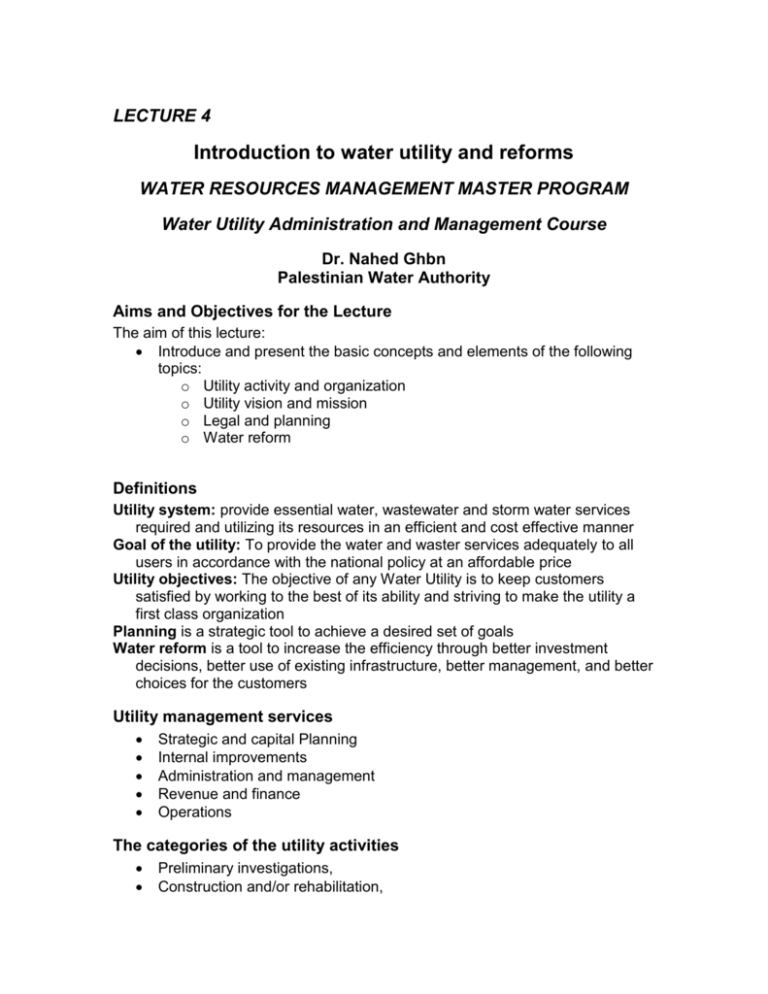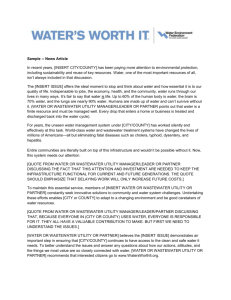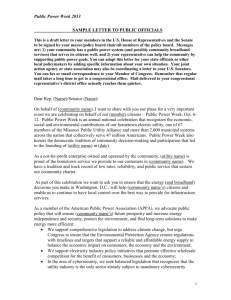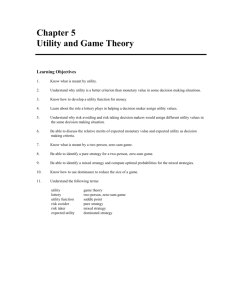LECTURE 4
advertisement

LECTURE 4 Introduction to water utility and reforms WATER RESOURCES MANAGEMENT MASTER PROGRAM Water Utility Administration and Management Course Dr. Nahed Ghbn Palestinian Water Authority Aims and Objectives for the Lecture The aim of this lecture: Introduce and present the basic concepts and elements of the following topics: o Utility activity and organization o Utility vision and mission o Legal and planning o Water reform Definitions Utility system: provide essential water, wastewater and storm water services required and utilizing its resources in an efficient and cost effective manner Goal of the utility: To provide the water and waster services adequately to all users in accordance with the national policy at an affordable price Utility objectives: The objective of any Water Utility is to keep customers satisfied by working to the best of its ability and striving to make the utility a first class organization Planning is a strategic tool to achieve a desired set of goals Water reform is a tool to increase the efficiency through better investment decisions, better use of existing infrastructure, better management, and better choices for the customers Utility management services Strategic and capital Planning Internal improvements Administration and management Revenue and finance Operations The categories of the utility activities Preliminary investigations, Construction and/or rehabilitation, Management Finance Major repairs Operation Maintenance Types of the water utilities Public Companies, owned by local or national government and governing to the same rules and regulations for commercial business Direct Municipal Management o Local management o Supra Local Management Private Sector Participation, improve economic efficiency and reduce the public budget deficits. Public-private partnerships, management, lease, BOT Private Ownership Palestinian water legal framework Palestinian Inter-Ministerial Co-ordination in the Water Sector Responsibilities of role players framework Mission & vision of the utility The mission is a statement of entity and purpose. It states who we are and what we do. It is a function of management, should be consistent with the national policy and goals to achieve the overall mission of the water resources management The vision is a clear image of what utility wants to be in the future. It indicates what we are striving to achieve and where we are headed. It is a function of leadership Relation between the vision and mission Examples of Mission & vision Mission example: To provide the water and wastewater services adequately to all users in accordance with the national policy at an affordable price To provide and maintain an adequate supply of safe water for consumption and fire protection, with quality service and at a reasonable price. Vision example: To be a regional and national water industry leader emphasizing quality product, services, and cost containment Types of planning Organizational Capital projects System growth Operations Financial Emergency Planning process Team Identify problems, planning objectives and constraints Defining the status Formulate alternatives Evaluate alternatives Implement the plan Exercise and update the plan Utility planning elements Personnel Organization Finance New opportunities Public and customer relations Operations and maintenance Safety and Risk Management Interagency and governmental Relations Technology Purchasing and procurement Capital projects planning Utility planning steps and options Selecting planning horizon Estimating market demand Comparing demand and capacity Adjusting output to demand Increase yield from existing supply systems Reduce demand. Education and public awareness. Price, incentives and regulation Use reclaimed water (wastewater and storm water) Expand supply system Planning time frames Short range 0 – 5 years Immediate needs Medium Range 0 – 10 years Utility mission Long range 0 – 20 years Utility vision Developing a management plan The main water reform policy Strengthening of regulatory and executive functions. Services should be demand-driven…based on the users’ willingness and ability to pay Financial and environmental sustainability. Human resources development. Community participation. Private sector participation. Separate regulatory and service delivery functions; Provide access to the market for competitors Reasons for water reform Inefficient and inappropriate water use Fragmented institutions Water supply quality and quantities problems Rising life-cycle costs in water infrastructure Lack of environmental awareness Bad staffing management and overstaffing No recognition for sustainable use of resources Lack of links between the various institutions for better cooperation and coordination Lack of management for wastewater and storm water as a resources Non-availability of water reuse High operational costs Objective of the water sector reform The main objective is to create economically viable and ecologically sustainable water industry leading to the sustainability. Enable and encourage utilities to achieve efficient and new service and performance standards with the purpose of ensuring service delivery to all citizens. Enable and encourage utilities to achieve operating cost recovery and cost effective operation. Encourage the private sector to finance, manage and operate projects in the sector, in a competitive manner not leading to monopoly. Create conditions for self-financing of Governorates water and wastewater projects in the future. Elements of the water reform Water policy Strategic planning and investment Water demand and water supply management o Tariff o Conservation and awareness o Water allocation o Efficiency improvements Financing, investment Private sector participation Institutional reform Local and regional cooperation The main challenges for water reforms Water to be treated as both a social and economic good. Water to be managed within a comprehensive framework, taking into account cross-sectoral considerations. Water to be managed at the lowest appropriate level, employing a demand-based approach and facilitating participation of all stakeholders. Institutional and policy reforms to be linked to incentives influencing decision making. Water reform process Institutional restructuring and responsibilities setup Integrated catchments management Separation between resource management and regulatory roles Greater responsibility at the local level for the services management Encourage privet sector participation and partnership Adopt new modern water demand techniques Pricing is to be based on the principles of full cost recovery to cover at least operation and maintenance Extension and future new investment should be economically viable and ecologically sustainable Comprehensive systems of water allocations or entitlements Greater public education and participation Appropriate research into water use efficiency technologies Key elements for sustainable utility Enabling environment through appropriate policy, regulation, standards and works Strong institutions with clear responsibility legitimate right, financial resources, strong leadership, ability Supportive attitude through establishing appropriate policies to motivate the utility staff and partnership with the community Appropriate service level Materials and equipment Continuous services improvements Public awareness Expertise and skills Use appropriate technology Comprehensive operation and maintenance programs References PWA reports and publications World Bank publications UMI materials COAG publications Water services improvement project in Gaza-PWA








